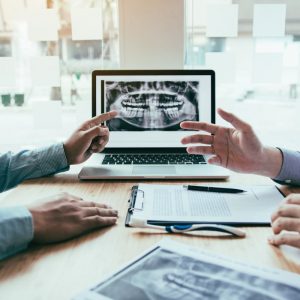
Digital dentistry is no longer some promise of the far-off future — it is happening now, and it is creating some amazing opportunities and outcomes for those willing to embrace it. The major transition to digital technologies only started 5-10 years ago, so we are still at the beginning phases of seeing where this technology will take us. As dental professionals, we will all need to develop new skills and knowledge if we want to see our practices grow.
We interviewed Gavan and Sean, of the Watersedge Dental Laboratory, to clarify where digital dentistry is going and how your practice can get on board.
What is Digital Dentistry?
A better question might be: “What isn’t digital dentistry these days?” Not just scanners and 3D printers, digital dentistry refers to any computer augmented service or process within a dental practice or dental lab.
We heavily invested in Digital Dentistry years ago at Watersedge when we started making super-accurate crowns from zirconia, a process that can only be accomplished using digital technology.
Examples of how Digital Dentistry is improving outcomes:
1. EMAX and PFM crowns are created from digitized models and cut with 3D mills to ensure accuracy, quality and reproducibility.
2. Nightguards are designed in 3D software and produced via 3D printers so when your patient’s dog chews up their appliance we can create a new one easily.
3. Clear aligners are created using sophisticated software to section out each tooth. This allows Watersedge to digitally place the teeth exactly as desired. The software automatically creates a series of intermediate aligners that allow for the patient’s teeth to move over time. It can even create animations showing the patient exactly what will happen in their mouth.
4. Dentures, the last catch-up to digital dentistry, have been analogue by nature due to the soft tissues of clients’ mouths. Within the next year or so, we will be producing digital dentures completely digitally. This will allow for a much more accurate fit and to quickly create replacements or conduct repairs.
5. Implants involve capturing a digital model by using a scan body. By inserting the scan body into the denture and then scanning the patient, a digital model can be created to determine the proper position of the denture. This process is much easier and more precise than screwing pieces together, gluing, test fitting, modifying, re-test fitting etc. not to mention more enjoyable for the patient.
6. Diagnostic tools are quickly moving to digital. For example, some intra-oral scanning systems are using infrared to find cavities. Simply by keeping digital records of a patient’s mouth Dentists can quickly identify changes and make diagnosis easier and faster.
7. Guided surgeries are becoming more common for good reason. By creating a digital model of the patient’s mouth using an intra-oral scanner and a CBCT scan, a precise and logical surgery plan can be designed. Watersedge works with many oral surgeons for everything from a single implant to a full bone graft. Your surgery guide will be developed under consultation, printed in 3d, and transmitted directly to your clinic ready to use.
4 Main Advantages of Digital Dentistry
1. Efficiency/accuracy. Prostheses can be made quickly and precisely with CAD (computer-aided design) and CAM (computer-aided manufacturing) technology. Changes to the fitting, colour, and so on are simplified as well.
2. Immediate feedback. You can send a scan to the lab and verify that it will work, while your patient is still in the chair.
3. Patient wellbeing and satisfaction. Digital radiography entails lower radiation than conventional X-rays. Patient comfort related to procedures such as mold creation is increased, as is satisfaction with the results, in terms of feel, colour, and so on.
4. Simplified recordkeeping. Digital records can now include 3d models of a patient’s mouth as well as historic scans and related files. Orthodontists, specifically, will save a huge amount of space by storing oral records on a USB stick instead of plaster molds.
How Watersedge Digital Dentistry Stands Out
Watersedge is an Ottawa dental lab with a difference. We offer optimal digital dentistry service to clinicians in a number of ways:
Scale. With a full range of digital dentistry equipment and a team of 42 employees (including several full-time delivery drivers), Watersedge is much better prepared to serve you than any of the smaller-scale labs in the Ottawa area.
Knowledge. Among our staff, we encourage knowledge-sharing rather than the usual competitive, siloed atmosphere. Consequently, your practice will have access to an extensive pool of professional knowledge and experience. We are also willing to research unusual cases and welcome challenging cases.
Training. Our employees are trained and certified in up-to-date dental technology such as iTero and Sirona Connect.
Responsibility. Mistakes can be very costly. Many other labs simply won’t take responsibility for errors. Watersedge does. If a crown fails, no matter whose fault it was, we will fix it… and deliver the fix directly to your clinic asap.
Responsiveness. You will need help as you transition to digital dentistry. Watersedge is open to answering all your questions and providing the benefit of our experience. We will modify our workflow to make it easier for any dentist to quickly get what they need. For example, we are happy to accept your old open or closed tray impressions and then work with you as you adopt new digital scanning techniques, ensuring you get the results both you and your patients demand.
Guidance As You Transition To Digital Dentistry
Whether you have recently purchased new equipment or you are still at the decision-making stage, feel free to reach out to us. Watersedge is happy to provide the guidance you need, including:
- assistance in choosing which digital tools/hardware to buy
- follow-up to your digital vendor’s training
- our new dentist guide, complete with a list of services, pictures, and prices
- a visit to your practice
- the opportunity to visit Watersedge for a demonstration of our digital tech